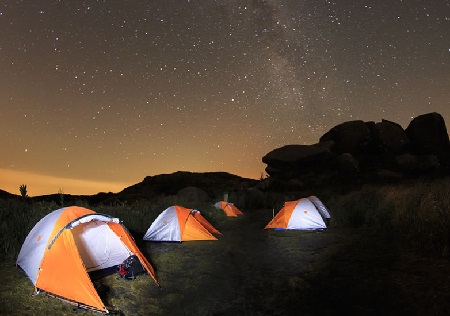 As the temperature drops, the rain fly cools down and warm air passes through the breathable lining of your tent. When it comes into contact with the cold rain fly or the cool floor of the tent, it condenses, forming water droplets.
As the temperature drops, the rain fly cools down and warm air passes through the breathable lining of your tent. When it comes into contact with the cold rain fly or the cool floor of the tent, it condenses, forming water droplets.
Creating air flow through the tent is the most effective way to reduce condensation. The Arizona tent is has vents all around that should be kept open, it also has a full coverage rain fly that should be properly setup in a way that it does not touch the inner tent.
Condensation in tents can happen to the most experienced campers. Have you woken up with moisture on the inside of your flysheet, or a pool of water in your tent? You would be forgiven for thinking that your tent has leaked during the night, but what has probably occurred is condensation, and it can put a real dampener on your camping trip. In this article we are going to take a look at why it occurs, and what steps you can take to prevent tent condensation forming.
If you have been unlucky enough to find water in your tent, it is very unlikely that your tent has leaked. NTK tents are made to the highest specification using quality materials and clever design. From tough, waterproof fabrics and stitch lines to strong stitching techniques and sealed seams, your tent is designed to keep the water out.
One person can produce up to 1 pint of condensation per night? So let’s say you have 5 people in a tent, that’s potentially 5 pints of water dropping inside your tent! Other likely sources of moisture are wet shoes, clothes, dogs, cooking, even the air itself! Warm air can hold more moisture than cold air, as the temperature falls at night the more moisture is released into the air. Fact, even without occupants, the air in a six man tent holds approximately 1 pint of water!
Rainy conditions can also increase the chances of condensation occurring, often leading to the appearance of a leaking tent. Rain water on the outside of the tent, or rain water evaporating off the outer surface of the tent causes the temperature of the fabric to decrease, leading to more rapid condensation as the air inside the tent comes into contact with it.
It is important to detect if you had water leakage or condensation, if you wake up during the night while it is pouring, grab a flashlight and scan your tent to find the water leakage and report this to us as soon as possible, NTK will always take care of you.
How can you prevent condensation in your tent?
Here are a few tips for a dry night!
1. Ventilate your tent!
The most effective way to prevent condensation is to ventilate your tent and reduce the internal humidity of your tent by promoting a good airflow. Make sure the rain fly is not touching the inner tent. Examine your tent for low and high venting options and open them to let the moist air flow out. If the weather conditions permit, leave the upper and lower sections of the door open, mesh sections can be kept fully zipped. If appropriate, also ensure vents of the tent are fully open. Make sure the vents are not obstructed by bags or any other stuff
 2. Store wet stuff outside
2. Store wet stuff outside
Towels, boots, waterproofs, swimming trunks, sweaty friends… keep that soggy, wet stuff out of the tent. Use a canopy to provide storage for wet kit.
3. Don’t touch the sides
If pressure is applied to the tent walls, water will try to seep through. Keep bags and other items away from tent walls and be mindful that condensation can collect when gear is leaned against the wall making it touch the rain fly
4. Never cook inside
Primarily for safety, but cooking also releases large amounts of moisture into the air. Remember that extractor fan in the kitchen at home?
5. Turn heaters off
Further warming the air inside the tent will increase water vapor in the air as warm air can support more moisture (our techy guys talk about dew points and percentage humidity, plus the warmer the tent is the more moisture will be released into the tent through evaporation and perspiration. Instead of heating the tent, warm yourself up with the right clothing and good sleeping bags.
6. Pitch in a spot that gets a natural breeze
Sheltered areas are more prone to generating condensation. Pitch your tent so that vents are lined up with the prevailing winds. It is better to have a nice warm sleeping bag than trying to close down all cold air flow.
7. Don’t pitch too close to water
Rivers and lakes can increase humidity. Pitching your tent a little further away from water sources can help reduce condensation.
8. Take spare towels
In some weather conditions condensation is difficult to avoid. Reduce it using the steps above and pack a spare towel to simply wipe it away.
